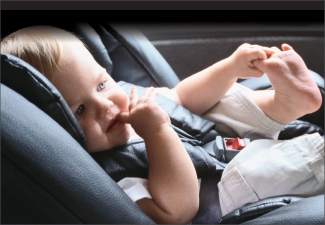
MEDIA RELEASE
From the Office of the Commissioner of Health Dr. Gale Burstein
June 17, 2015
Contact: Mary C. St. Mary / Mary.StMary@Erie.Gov
Phone: (716) 858-4941 / Mobile: (716)253-3925
How to Avoid Child Deaths in Hot Cars
Take Steps to Avoid this Preventable Tragedy
ERIE COUNTY, NY — Kids and hot cars are a deadly combination. Heat stroke is the leading cause of non-crash, vehicle-related deaths in children under 15 years. In 2014, more than 30 children in the U.S. – including a baby in New York State – died from heatstroke after being left alone in hot cars. These deaths are even more tragic because they could have been prevented.
“Heat stroke can happen when the body is not able to cool itself quickly enough,”  said Erie County Health Commissioner Dr. Gale Burstein. “A child's body heats up three to five times faster than an adult's does. When left in a hot car, a child's major organs begin to shut down when his temperature reaches 104 degrees Fahrenheit (F). A child can die when his temperature reaches 107 degrees F.”
said Erie County Health Commissioner Dr. Gale Burstein. “A child's body heats up three to five times faster than an adult's does. When left in a hot car, a child's major organs begin to shut down when his temperature reaches 104 degrees Fahrenheit (F). A child can die when his temperature reaches 107 degrees F.”
Cars heat up very quickly. In just 10 minutes, a car’s inside temperature can rise 20 degrees F. Cracking a window and/or air conditioning does very little to keep the car cool once the engine is turned off. It also does not need to be a very hot day; heat stroke can happen when the outside temperature is as low as 57 degrees F. Burstein added: “Infants and young children are sensitive to the effects of extreme heat, and must rely on other people to keep them cool and hydrated.”
Any parent or caregiver, even a very loving and attentive one, can forget a child is in the back seat, especially when busy or distracted or having a change from the usual routine. Here are reminders to prevent the unthinkable from happening to a child:
- Always check the back seat
- Make sure all children are out of the car before locking it and walking away
- Avoid distractions while driving, especially cell phone use
- Be extra alert when there is a change in your routine (someone else is driving your child or you take a different route to work or child care)
- Have your child care provider call if your child is more than 10 minutes late
- Put your cell phone, briefcase or purse in the back seat, so you check the back seat when you arrive at your destination
- If someone else is driving your child, always check to make sure he has arrived safely
Keep your car locked when it is parked to prevent a curious child from entering when no one is around. Many hot car deaths have occurred when a child mistakenly locks himself inside.
- Make sure children do not have easy access to your car keys. Store them out of a child's reach.
- Teach children that cars are not safe places to play.
- Keep rear fold-down seats closed to prevent a child from crawling into the trunk from inside the car.
- Remind children that cars, especially car trunks, should not be used for games like hide-and-seek.
Family pets can also succumb to heatstroke in unattended vehicles. Mild weather can seem deceptively safe, but it is not. In less than 30 minutes, the temperature inside a car can rise more than 30 degrees higher than the temperature outside. This is true even if car windows are cracked open or the car is parked in the shade. Dogs can’t cool themselves down as easily as we can, and once they overheat, they can suffer serious organ damage and die. Never leave an animal alone in a car.
For more information:
American Academy of Pediatrics
American Society for the Prevention of Cruelty to Animals

